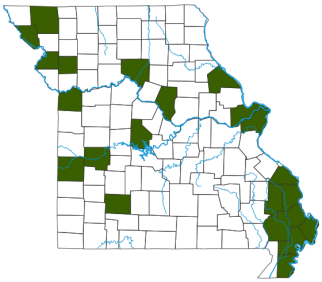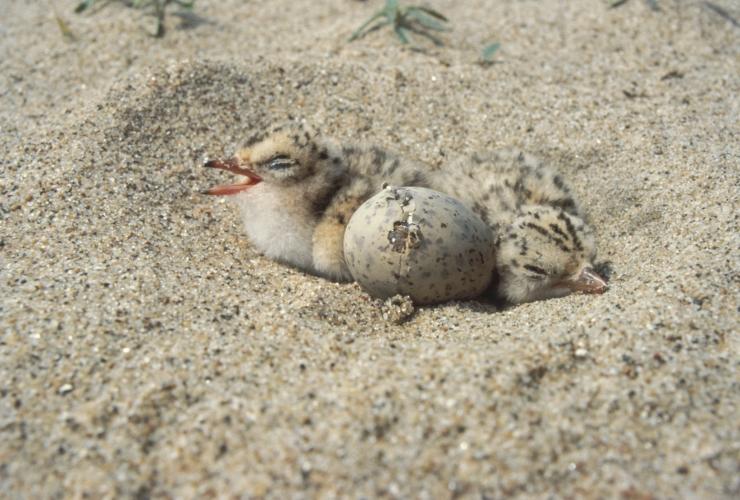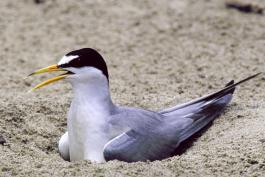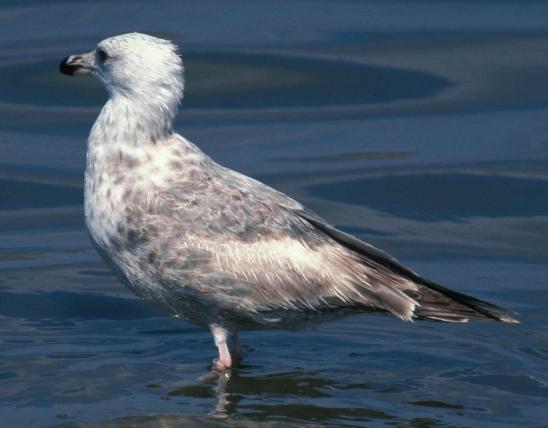
The least tern is the smallest tern in America, gray above and white below. The head is white with a black cap and nape and a white forehead. The outermost primaries are black, the sharp-pointed bill is yellow-orange with a black tip, and the legs are yellow. The tail is short and deeply forked. Late-summer juveniles are brownish above with dark Vs on the back and have dark eye patches. The voice is high and shrill, with 2 or 3 syllables.
Length: 9 inches (tip of bill to tip of tail); wingspan: 20 inches.

Most likely to be found on the Mississippi River from Cape Girardeau and south, but potentially could appear on other big rivers, too.
Habitat and Conservation
Originally, the least tern lived on islands, beaches, and sandbars in big rivers (in our state, especially the Mississippi and Missouri), but as these areas became rare, these birds have been forced to make do with dredge islands, dike fields, sandpits, and gravel roads atop levees.
This rare summer resident forages over water for small fish, which it captures by diving into the water. In the past, least terns nested on sandbar islands in the Mississippi and Missouri rivers. Human alterations to the rivers destroyed much of their habitat. Thanks to conservation efforts, nesting least terns are increasing on sandbar islands on the Missouri.
Food
This bird dives into water to catch its prey, which is almost entirely small fish. Nests are generally located near shallow water where small fish are abundant.
Status
Rare summer resident foraging over water, particularly the Mississippi River from Cape Girardeau and south. Rare transient otherwise.
Missouri's particular subspecies is the interior least tern (Sterna antillarum athalassos). From 1985 until 2021, it was listed as endangered by the U.S. federal government. In 1985, the population was estimated at fewer than 2,000 adults nesting in a few dozen scattered colonies along the Mississippi River and its tributaries. Successful conservation efforts have led to its being delisted by the federal government. As of 2021, the estimated population is around 18,000. It remains a species of conservation concern in Missouri.
Life Cycle
This species arrives in late April to May. Females lay 1–4 eggs in late May, and incubation lasts about 20–25 days. Young reach fledgling stage in 3–4 weeks but remain with their parents until migration. They depart our state in August and September. No one knows for sure where they overwinter. Least terns can live 10 years or more.
Human Connections
It’s an intrinsic part of our human nature to want to find the answers to questions, and many questions remain about this small tern. We’re not even sure where it spends the winter. For the sake of our curiosity alone, it is important for this species to survive.
Ecosystem Connections
This bird preys on small fish, and its pre-fledgling young provide food for various other predators. As a migratory species, this bird plays a role not only in Missouri, but also where it overwinters as well as the places it passes through as it migrates.





Where to See Species
About 350 species of birds are likely to be seen in Missouri, though nearly 400 have been recorded within our borders. Most people know a bird when they see one — it has feathers, wings, and a bill. Birds are warm-blooded, and most species can fly. Many migrate hundreds or thousands of miles. Birds lay hard-shelled eggs (often in a nest), and the parents care for the young. Many communicate with songs and calls.


























